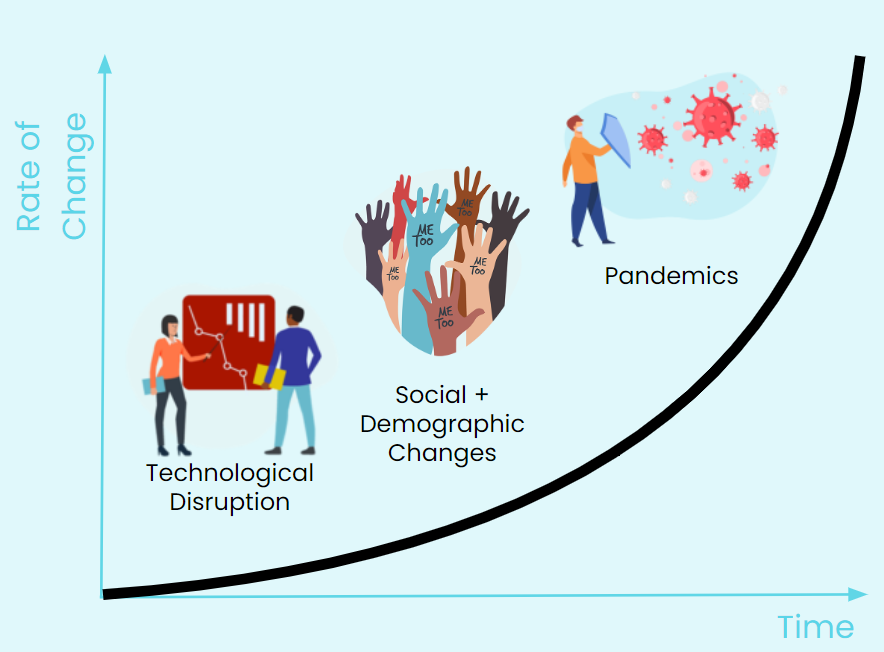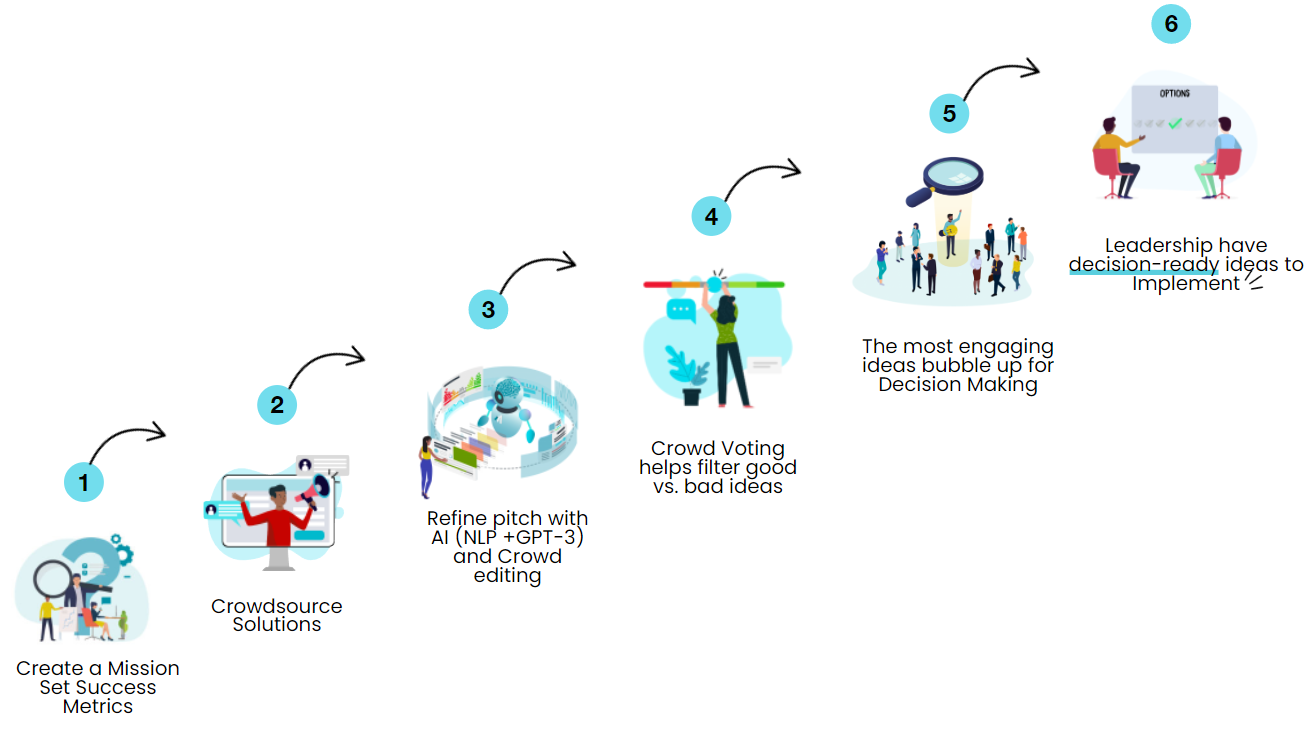Creating a Speak Up Culture and Maximizing Engagement
[Swae’s 5-Step Organizational Readiness Checklist]
6 min read

The desire to engage employees and create a more diverse, inclusive culture where people feel free to speak up is an obvious win-win for everyone in an organization (if you don’t believe us, then please read MIT Sloan Management’s Review that shares that When Employees Speak Up, Companies Win).
This study found that:
Organizations face new challenges daily…

Tech is evolving rapidly, Social needs are changing, Demographic power is shifting and COVID is impacting global norms. This all results in more and more challenges for organizations to tackle…
…and their people are the #1 source to finding good solutions to them
- Internal employees 60%
- Technology partners 50%
- Channel & Business Model Partners 44%
- Customers (via focus groups, data mining, feedback) 35%
- Supply Chain Partners / Vendors 29%
- Similar organizations outside regional market 23%
- Academics & Research organizations 22%
- Entrepreneurs, Startups 16%
Source: PwC Innovation Benchmark

SO WHAT NEXT?
How do you get started to create a more inclusive speak-up culture?
There are many things to consider when creating this type of culture in your workplace, and finding a good technology that can support inclusivity can make your life easier. Making the investment to help your workplace deepen collaboration, get more organized, and be more productive are critical steps.
But, is your organization ready to implement a platform like Swae?
You may be wondering, why would Swae even require preparation?
Because Swae is way more than a simple voting/crowdsourcing/survey platform; it’s a robust, community-driven, and consensus-building platform that enables decision-making that’s driven by collective intelligence.
Leadership within a company needs to truly value (and want to hear) employees’ voices, and should be OK with making commitments to make decisions. There’s an underlying social contract within Swae, because we’re in direct opposition to the closed-door, top-down hierarchical decision-making approach (the old way of doing things).
If you’d like a quick review from Swae’s CEO/Founder, Soushiant Zanganehpour, please watch this quick video here (or keep reading on below).
CHECKLIST
The Top 5 Things Your Organization Needs Before Implementing Swae
BELIEF IN CROWDSOURCING
A Relevant Topic or Mission
Get strategic about what you want to tackle using Swae: You’ll want to have a strategic desire to solve organizational challenges and to crowdsource ideas and solutions for these from a larger group in a more robust manner than ever before.
And, leadership should be ready with decision-making processes to surround the work (we have a free decision-making guide here if you’d like some of our recommendations).
The Swae team can help your organization target and define the challenges to begin, but the organization should be ready to unlock the collective intelligence of your people.
SWAE WORKS BEST AT SCALE
Enough People to Collaborate with
You’ll want to have approx. 20 or more people toget the very best from Swae:
This means that you’ll want to open a mission (or more than one mission) up to at least that many people as this will bring you more success in getting better engagement.
Small teams can more effortlessly create inclusive cultures as there isn’t as much hierarchy and layers. Since Swae works on collective intelligence, the more people the better!
A LITTLE TIME
Ongoing time needed to manage Swae
Once you’re up and running and you have missions already going within the platform, you’ll want to commit to about ~ 1 or so hours a week (dependent on how many missions you’re running at a time).
This is for the ongoing time that’s necessary to review the proposals people are writing for new ideas and inputting into the platform, share feedback, check the crowdsourcing/votes, and improve the success of engagement ongoing, including communication with all stakeholders. This would be dependent on how you break up the tasks with admins/leaders in your company.
IDEAS NEED DECISIONS
Executive Buy-in to Make Decisions
ACTION
Idea Enablement Plan
You’ll want to create a rough plan for how winning ideas might be implemented and any incentives you’d like to provide: You can create employee engagement money incentives, prizes, or other perks like extra time off, etc. Having an ongoing incentivization strategy can support your ongoing efforts to create a more inclusive (and engaged) culture.
Quick Overview on How Swae Works
This is the methodology of Swae to help you understand the features and functions of the platform so that it makes more sense in HOW you do the above.
Swae is layered, and each of the layers are important. Here’s a quick breakdown:
- Organization: The first layer is the organization. It’s important to strategically choose the missions you want to take on; these are the challenges you want to find new and improved ideas for, or problems that need solutions from a larger set of people to source from.
- Missions and Challenges: Once you’ve chosen the missions you want to start getting ideas for, you’ll set up the unique parameters for the exact goals you want to hit, escalation metrics, and whatever specific parameters that are right for your company.
- Proposal creation: Once you start collecting the ideas from your employees or customers, the proposals they write will go through an AI review process to ensure they’re well-written and more formalized. Once their proposals are input, other people can collaborate on those and vote to help you filter out the best of the best ideas. The proposed ideas or solutions that bubble up to the top would be the ones that are presented to your committee for decision-making. The proposed ideas that don’t escalate to the top will go into the archives on Swae.
A straightforward & seamless process

The size of your organization could be as small as 50-100 people like the way LifeLabs used Swae. They had one decision maker and used ¼ of a coordinator’s time. They met quarterly to review ideas, and the monies they had to allocate to their efforts also helped turn some of the ideas into a reality.
You can have something as small and manageable as LifeLabs, or you can have a situation that’s as extensive and large as what Etihad Airways used Swae for; this enterprise had 20,000 people and a larger fund to invest in various ideas wrapped around innovation. Etihad used Swae to collect new product development ideas, new operational improvements, and more. They created an accelerator program and other sorts of things that were combined with what they did on Swae, but it doesn’t need to be as extensive as that. You could utilize a project management office that reviews proposals and works with an individual over a period to turn an idea into reality without an entire program.
You can gain a much better visual as to how Swae works by watching this video
RESULTS
Speak up cultures pay back…
Using Swae to nurture a culture shift in your team where everyone becomes comfortable to speak up sounds fantastic- but what about the hard numbers?
In almost every instance, Swae delivers incredible payback- not just in terms of employee motivation & satisfaction, but in cold, hard strategy that you can turn into actionable, profitable ideas…
$1M+
avg. value of innovation ideas revealed over 12 months.
70%+
increase in engagement of your employees*.
$1M
direct cost saving ideas have been generated.
3M
3 Month average payback period.
25-50%
improvement in time saved by administrators managing idea generation program.
50%
improvement in sourcing investable decisions*.
Results based on aggregated findings and impacts reports from client implementations.
*Over and above other engagement tools & approaches used.
No-one knows our business better than our employees, that’s why we partnered with Swae to give them the platform they need to innovate.

Tony Douglas CEO of 

NEXT STEPS…
Still wondering about Swae?
Worried about how it’ll work inside your organization? Not sure if you really need Swae today?
We’ve got your back– just drop us a message and one of our team will talk openly and honestly with you about how Swae can benefit you (it works magic for 99% of teams)- and if its not a good fit for right now then we’ll all happily carry on with our day. So drop us a line and let’s chat 🙂
More to explore…
How to be seen as a Brilliant and Bold Leader [Become a great Communicator]
How to be seen as a Brilliant and Bold Leader [Become a great Communicator] 1 June 2022 4 min ReadThis is a recap of Harvard Business Review @HarvardBiz ’s Good Leadership is About Communicating Why, by Nancy Duarte @nancyduarte. Becoming a bold leader means that...
Being Honest in Leadership Roles Helps Drive Innovation and Long-Term Success
Being honest in Leadership roles helps drive Innovation and long-term Success Doing Decision-Making Right Without Blinders On23 May 2022 5 min ReadThis is a recap of Harvard Business Review’s @HarvardBiz “Decisions Without Blinders” study. Being honest in leadership...
Many Companies Are Hiring Immediately [Research Shows People Desire Better Workplaces]
Many Companies Are Hiring Immediately [Research Shows People Desire Better Workplaces] Workers Are Quitting Their Jobs Like Never Before 15 May 2022 4 min ReadMany companies are hiring immediately and there’s a big reason why. U.S. workers are quitting their jobs like...

![How to be seen as a Brilliant and Bold Leader [Become a great Communicator]](https://swae.io/wp-content/uploads/Resources_Swae_Harvard_Business_review_How-to-Be-Seen-as-a-Brilliant-and-Bold-Leader-Become-a-Great-Communicator-400x250.png)

![Many Companies Are Hiring Immediately [Research Shows People Desire Better Workplaces]](https://swae.io/wp-content/uploads/Rew_Research_Swae_Many-Companies-Are-Hiring-Immediately-Research-Shows-People-Desire-Better-Workplaces-1-400x250.png)
Can you be more specific about the content of your article? After reading it, I still have some doubts. Hope you can help me. https://accounts.binance.com/pt-BR/register?ref=P9L9FQKY
Your point of view caught my eye and was very interesting. Thanks. I have a question for you. https://accounts.binance.com/fr/register-person?ref=V2H9AFPY
Your article made me suddenly realize that I am writing a thesis on gate.io. After reading your article, I have a different way of thinking, thank you. However, I still have some doubts, can you help me? Thanks.
Thank you very much for sharing. Your article was very helpful for me to build a paper on gate.io. After reading your article, I think the idea is very good and the creative techniques are also very innovative. However, I have some different opinions, and I will continue to follow your reply.
Can you be more specific about the content of your enticle? After reading it, I still have some doubts. Hope you can help me. https://accounts.binance.com/en/register?ref=P9L9FQKY
Reading your article has greatly helped me, and I agree with you. But I still have some questions. Can you help me? I will pay attention to your answer. thank you.
I don’t think the title of your article matches the content lol. Just kidding, mainly because I had some doubts after reading the article. https://www.binance.com/sl/register?ref=UM6SMJM3
This article opened my eyes, I can feel your mood, your thoughts, it seems very wonderful. I hope to see more articles like this. thanks for sharing.
Your article gave me a lot of inspiration, I hope you can explain your point of view in more detail, because I have some doubts, thank you.
I am currently writing a paper and a bug appeared in the paper. I found what I wanted from your article. Thank you very much. Your article gave me a lot of inspiration. But hope you can explain your point in more detail because I have some questions, thank you. 20bet
Apoiar ferramentas de apostas e estar equipado com uma plataforma diversificada de transações financeiras, a 20Bet oferece suporte tangível aos jogadores. Este é um lugar onde eles podem apostar com dinheiro real, respaldados por concorrentes de diversas disciplinas esportivas. 20bet
Thank you very much for sharing, I learned a lot from your article. Very cool. Thanks. nimabi
Your point of view caught my eye and was very interesting. Thanks. I have a question for you. https://www.binance.com/uk-UA/join?ref=B4EPR6J0
How To Create Website Audit report for free ? watch this https://www.youtube.com/watch?v=CxzaJOyFnQc
thats great article..
I loved even more than you will get done right here. The picture is nice, and your writing is stylish, but you seem to be rushing through it, and I think you should give it again soon. I’ll probably do that again and again if you protect this hike.
E-commerce Marketing New Jersey
upysm.com 是一個專業的社交媒體推廣平台,提供各種刷粉絲服務,讓您的Instagram、Facebook、Youtube等帳號快速增加人氣和影響力。無論您是個人創作者還是企業品牌,我們都可以為您量身定制最合適的方案,讓您在社交媒體上脫穎而出。
Although I enjoy your website, you should proofread a few of your pieces. Many of them have serious spelling errors, which makes it difficult for me to convey the truth. Nevertheless, I will definitely return.
Say hello to efficient content creation with Cluc.io.
Your ability to distill complex ideas into understandable content is unmatched. Thanks!
Hello my loved one I want to say that this post is amazing great written and include almost all significant infos I would like to look extra posts like this
Мадонна, икона поп-музыки и культурного влияния, продолжает вдохновлять и поражать своей музыкой и стилем. Её карьера олицетворяет смелость, инновации и постоянное стремление к самовыражению. Среди её лучших песен можно выделить “Like a Prayer”, “Vogue”, “Material Girl”, “Into the Groove” и “Hung Up”. Эти треки не только доминировали на музыкальных чартах, но и оставили неизгладимый след в культурной и исторической панораме музыки. Мадонна не только певица, но и икона стиля, актриса и предприниматель, чье влияние простирается далеко за рамки музыкальной индустрии. Скачать mp3 музыку 2024 года и слушать онлайн бесплатно.
I loved as much as youll receive carried out right here The sketch is attractive your authored material stylish nonetheless you command get bought an nervousness over that you wish be delivering the following unwell unquestionably come more formerly again as exactly the same nearly a lot often inside case you shield this hike
Somebody essentially help to make significantly articles Id state This is the first time I frequented your web page and up to now I surprised with the research you made to make this actual post incredible Fantastic job
Thank you for the auspicious writeup It in fact was a amusement account it Look advanced to far added agreeable from you However how can we communicate
What i dont understood is in reality how youre now not really a lot more smartlyfavored than you might be now Youre very intelligent You understand therefore significantly in terms of this topic produced me personally believe it from a lot of numerous angles Its like women and men are not interested except it is one thing to accomplish with Woman gaga Your own stuffs outstanding Always care for it up
Its like you read my mind You appear to know a lot about this like you wrote the book in it or something I think that you could do with some pics to drive the message home a little bit but instead of that this is fantastic blog An excellent read I will certainly be back
Thank you for your sharing. I am worried that I lack creative ideas. It is your article that makes me full of hope. Thank you. But, I have a question, can you help me?
Hello i think that i saw you visited my weblog so i came to Return the favore Im trying to find things to improve my web siteI suppose its ok to use some of your ideas
Its like you read my mind You appear to know a lot about this like you wrote the book in it or something I think that you could do with some pics to drive the message home a little bit but instead of that this is fantastic blog An excellent read I will certainly be back
We provide the best sports casino software. Please visit our website솔루션분양
Your article helped me a lot, is there any more related content? Thanks!
Your positivity and enthusiasm are infectious I can’t help but feel uplifted and motivated after reading your posts
It’s clear that you truly care about your readers and want to make a positive impact on their lives Thank you for all that you do
Can you be more specific about the content of your article? After reading it, I still have some doubts. Hope you can help me.
I do agree with all the ideas you have introduced on your post They are very convincing and will definitely work Still the posts are very short for newbies May just you please prolong them a little from subsequent time Thank you for the post
[먹튀검증] 카지노커뮤니티 이용으로 먹튀검증 및 토토사이트 먹튀를 예방하세요.
you are truly a just right webmaster The site loading speed is incredible It kind of feels that youre doing any distinctive trick In addition The contents are masterwork you have done a great activity in this matter
Nice blog here Also your site loads up very fast What host are you using Can I get your affiliate link to your host I wish my site loaded up as quickly as yours lol
Fantastic site Lots of helpful information here I am sending it to some friends ans additionally sharing in delicious And of course thanks for your effort
My brother suggested I might like this blog He was totally right This post actually made my day You can not imagine simply how much time I had spent for this info Thanks
Thank you for your sharing. I am worried that I lack creative ideas. It is your article that makes me full of hope. Thank you. But, I have a question, can you help me?
This piece was incredibly enlightening! The level of detail and clarity in the information provided was truly captivating. The extensive research and deep expertise evident in this article are truly impressive, greatly enhancing its overall quality. The insights offered at both the beginning and end were particularly striking, sparking numerous new ideas and questions for further exploration.The way complex topics were broken down into easily understandable segments was highly engaging. The logical flow of information kept me thoroughly engaged from start to finish, making it easy to immerse myself in the subject matter. Should there be any additional resources or further reading on this topic, I would love to explore them. The knowledge shared here has significantly broadened my understanding and ignited my curiosity for more. I felt compelled to express my appreciation immediately after reading due to the exceptional quality of this article. Your dedication to crafting such outstanding content is highly appreciated, and I eagerly await future updates. Please continue with your excellent work—I will definitely be returning for more insights. Thank you for your unwavering commitment to sharing your expertise and for greatly enriching our understanding of this subject.
This piece was incredibly enlightening! The level of detail and clarity in the information provided was truly captivating. The extensive research and deep expertise evident in this article are truly impressive, greatly enhancing its overall quality. The insights offered at both the beginning and end were particularly striking, sparking numerous new ideas and questions for further exploration.The way complex topics were broken down into easily understandable segments was highly engaging. The logical flow of information kept me thoroughly engaged from start to finish, making it easy to immerse myself in the subject matter. Should there be any additional resources or further reading on this topic, I would love to explore them. The knowledge shared here has significantly broadened my understanding and ignited my curiosity for more. I felt compelled to express my appreciation immediately after reading due to the exceptional quality of this article. Your dedication to crafting such outstanding content is highly appreciated, and I eagerly await future updates. Please continue with your excellent work—I will definitely be returning for more insights. Thank you for your unwavering commitment to sharing your expertise and for greatly enriching our understanding of this subject.
먹튀 피해를 100% 예방하고 싶으신가요? [먹튀검증]으로 안전하고 신뢰할 수 있는 온라인 베팅 환경을 경험하세요.
I’m genuinely grateful for the information you’ve shared here.
[PDF] The Summer Pact BY Emily Giffin
[PDF] The Drowning House BY Cherie Priest
My brother suggested I might like this blog He was totally right This post actually made my day You can not imagine simply how much time I had spent for this info Thanks
Your writing is not only informative but also incredibly inspiring. You have a knack for sparking curiosity and encouraging critical thinking. Thank you for being such a positive influence!
Belhaven University’s unique combination of diverse programs and majors sets it apart from other universities, including state universities. The university’s commitment to providing a holistic and personalized education ensures that students receive the attention and support they need to thrive academically and professionally. Whether pursuing their passion in the arts, honing their business skills, or making a difference in healthcare, students at Belhaven University are equipped with the knowledge, skills, and experiences necessary for success in their chosen fields.
Your blog is a true hidden gem on the internet. Your thoughtful analysis and in-depth commentary set you apart from the crowd. Keep up the excellent work!
From start to finish, this blog post had us hooked. The content was insightful, entertaining, and had us feeling grateful for all the amazing resources out there. Keep up the great work!
I have read some excellent stuff here Definitely value bookmarking for revisiting I wonder how much effort you put to make the sort of excellent informative website
you are in reality a just right webmaster The site loading velocity is incredible It seems that you are doing any unique trick In addition The contents are masterwork you have performed a wonderful task on this topic
I have read some excellent stuff here Definitely value bookmarking for revisiting I wonder how much effort you put to make the sort of excellent informative website
Thank you I have just been searching for information approximately this topic for a while and yours is the best I have found out so far However what in regards to the bottom line Are you certain concerning the supply
I loved as much as you will receive carried out right here The sketch is attractive your authored material stylish nonetheless you command get got an impatience over that you wish be delivering the following unwell unquestionably come more formerly again since exactly the same nearly a lot often inside case you shield this hike
Somebody essentially help to make significantly articles Id state This is the first time I frequented your web page and up to now I surprised with the research you made to make this actual post incredible Fantastic job
I have been surfing online more than 3 hours today yet I never found any interesting article like yours It is pretty worth enough for me In my opinion if all web owners and bloggers made good content as you did the web will be much more useful than ever before
The degree of my fascination with your creations is equal to your own enthusiasm. The sketch is tasteful, and the authored material is of a high caliber. Yet, you appear uneasy about the prospect of heading in a direction that could cause unease. I’m confident you’ll be able to resolve this situation efficiently.
of course like your website but you have to check the spelling on several of your posts A number of them are rife with spelling issues and I in finding it very troublesome to inform the reality on the other hand I will certainly come back again
I loved as much as you will receive carried out right here The sketch is attractive your authored material stylish nonetheless you command get got an impatience over that you wish be delivering the following unwell unquestionably come more formerly again since exactly the same nearly a lot often inside case you shield this hike
Fantastic beat I would like to apprentice while you amend your web site how could i subscribe for a blog site The account helped me a acceptable deal I had been a little bit acquainted of this your broadcast offered bright clear concept
탑플레이어 포커 머니상 – 포커 머니 거래의 편리함을 경험하세요! 간편하고 빠른 거래 시스템으로 누구나 쉽게 포커 머니 거래를 할 수 있습니다. https://youtu.be/1lX8DVfhzTY?si=nONw6ugU8dmZNr5W
Your writing has a way of making even the most complex topics accessible and engaging. I’m constantly impressed by your ability to distill complicated concepts into easy-to-understand language.